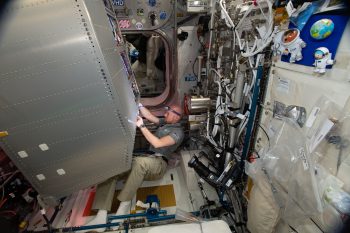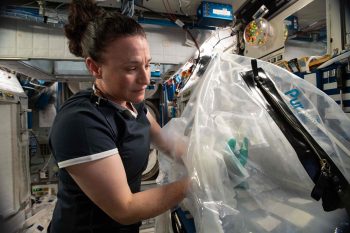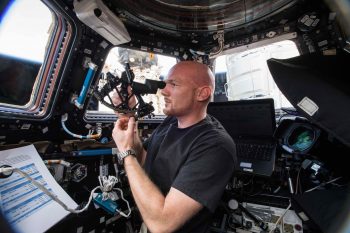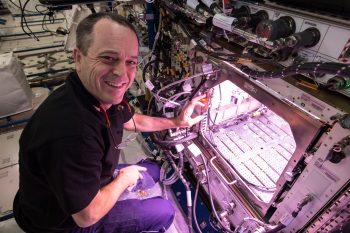Translated from Alexander’s original German blog text by the Horizons team.
We had a visit from Earth! The SpaceX Dragon CRS-15 resupply vehicle arrived Monday 1 July bringing provisions, new scientific experiments and a whole lot more work for the crew on board the International Space Station (ISS).

ESA astronaut Alexander Gerst installing a new video management unit in the Fluid Science Laboratory. Credit: ESA/NASA
Thanks to this exciting arrival, the past few weeks have been even busier than usual. Ricky and Drew captured the capsule with the robotic arm, which is always a tricky manoeuvre and requires full concentration. Then we began the unloading.
Some materials and equipment had to be cooled immediately. And because the Dragon was also supposed to bring a whole series of completed experiments back to Earth, we had to hurry to get them done in time. As a result, we have spent more than 104 hours a week on research – just short of the ISS team record!
In the Columbus module I was responsible for commissioning the MagVector experiment, after a conversion that allows researchers to investigate how magnetic fields deflect cosmic radiation. I also installed a new camera in the Fluid Science Laboratory – a facility used to investigate the dynamics of foams and granules in weightlessness.
In the US module, we’ve been cultivating algae and Arabidopsis plants, carrying out research into cancer cells and even mixing “space concrete”. Here in weightlessness, where no disturbing convection fluxes occur in the material, we’re able to produce particularly pure cement and concrete. The benefits of this are twofold. On the one hand, it helps us better assess the properties of these very important building materials and improve their production on Earth. On the other, we gain experience that could be very useful for us when it comes to constructing a future Moon base.

NASA astronaut Serena Auñón-Chancellor mixes concrete. Credit: ESA/NASA-A.Gerst
On top of all this research, we also had time for a very special exercise. It’s one I had been looking forward to for a long time: Serena and I were to attempt to navigate by the stars from the ISS Cupola using a sextant.
As a huge fan of exploration, the idea that we would be using a sextant was extremely cool for me. Functioning like a protractor, it’s a tool that allows you to determine your position based on the orientation of celestial bodies. This is not only possible on the ground, but also up in space.
Navigating by sextant aboard the ISS may seem antiquated at first glance. But optical angle measurement was vital in helping the Apollo 13 astronauts return to Earth after an explosion on board their spacecraft in 1970. And NASA and ESA want to equip us with this almost 300-year-old invention for future missions to the Moon or Mars for that very reason – in case of emergency.
But, before they do so, it needs to prove its worth. So, from the Cupola, Serena and I tried to measure the angles between certain stars.
We quickly realized that the exercise planners, who know almost every star in the night sky inside out, were more concerned about technical questions – how the light comes in or where to attach the foot straps in order to assume a stable observation position. What they hadn’t considered, however, was that the most important thing when using a sextant on board the ISS is having an exact star map for the planned observation time.
You can see so many stars through the windows of the ISS (especially on a moonless night) that you can hardly find your way around. The constellations no longer stand out, and the section of the “sky” is relatively small, making it rare to be able to see the entire constellation. Moreover, our Space Station rotates around itself at four degrees per minute, so you can only see each star for a few minutes at a time before it either disappears behind the Earth’s horizon or is covered by part of the ISS structure. We managed quite well, but we still have some work to do to determine the best way forward.

ESA astronaut Alexander Gerst uses a sextant on board the International Space Station. Credit: ESA/NASA
This is often the case in space travel; in practice, completely different problems become important than those that have been carefully considered beforehand. To close this gap, you need astronauts.
The sextant exercise is also a good example of how we as astronauts deal with the risks of our missions. We rely on many different safety grids, and develop a plan B, C, D and E for as many scenarios as possible.
For example, recently we had a power failure on board the ISS, during which one of eight solar array power channels collapsed early in the morning following the unfavourable impact of a cosmic elementary particle. A second channel had been deactivated earlier due to the low sun angle. And, because the current load was then transferred to the other circuits, a third channel also collapsed before the system was able to recover.
Fortunately, no vital systems – such as the cooling system of the station – were affected. They are always fed by several independent solar array wings. But the onboard alarm woke us pretty swiftly from our sleeping cabins. We couldn’t coordinate with the ground control team because we were in a dead spot. So first we had to tackle the problem on our own. In pyjamas.
It’s at this point that we are reminded: the ISS is a highly complex system that is floating alone in the hostile cosmos. Even a power failure like this could rapidly result in serious consequences if there were not so many redundancies in place to ensure safety.
You can imagine our Space Station as a mobile that hangs over a baby’s crib, with many colourful figures on it, in perfect balance. If you cut part of the mobile off, it will affect the rest and put it in danger of falling off balance. The art is to build the mobile in such a way that error chains do not spread so far, and that the largest part of the structure always remains stable.
In this respect, the ISS is very cleverly designed. It can re-balance itself within seconds by cutting off power supply to non-vital areas. But to get all the important components – such as life support, cooling, navigation and communication systems – back up and running, astronauts must intervene.

NASA astronaut Ricky Arnold. Credit: ESA/NASA-A.Gerst
As astronauts, we train for a long time to keep calm in such critical situations and not lose sight of the system as a whole. It’s important to adapt to the special, exposed environment up here not just physically, but also mentally. From parachute jumping to deep diving underwater or a month-long research stay in extreme polar cold, our bodies are remarkably well-equipped to handle different environments and situations. It’s the mind that matters the most.
What really fascinates me about these kinds of environments is not the danger, the isolation or the adrenaline. On the contrary, I don’t like any of those three things very much. What I do like, is the possibility of conquering, controlling and mastering such a hostile environment and using it for our scientific benefit. And then ending up feeling at home in a place that’s so far from it.
That’s what drives me on such expeditions – and what makes up for the risk or suffering up here in space.




Discussion: 28 comments
Das ist total spannend und interessant. Herzlichen Dank dafür und für Ihre Mission
Vielen, herzlichen Dank für diesen sehr interessanten Beitrag. Er lies sich wirklich wie ein gut geschriebener si-fi Roman und man hatte das Gefühl, man steckt selber mit drin.
Übrigens, es wäre bestimmt ein großer Beitrag für das autofahrende Volk, wenn Ihr da oben herausfinden könnt, wie Straßenbeton nicht so schnell kaputt geht
Ich bin mit meinen Gedanken sehr oft bei Euch und wünsche Euch das allerbeste, keine Havarien mehr, viel Gesundheit, Glück und Freude.
Mit herzlichen Grüßen Bärbel Stellmacher
Lieber @astro_alex
Danke für deine Eindrücke aus dem All. Deine Tweets, Photos und Texte sind eine große Inspiration für Groß und Klein. Hoffe sehr dass die Masse, die du durch das Netz erreichst, unser Planet besser schützen und lieben lernt. Ich zähle auf jeden Fall dazu. Schöne Grüße aus Köln
Es ist so unglaublich spannend, über das Leben und Arbeiten auf einer Raumstation zu lesen! Du schreibst so anschaulich, Alexander, dass ich alles wie in einem Film vor mir sehe. Danke dafür und weiterhin viel Erfolg und schöne Erlebnisse!
Hallo Alex!
Galaktischen Dank für diesen interessanten Bericht!
Wenn schon ein kleines Elementarteilchen einen solchen Schaden verursachen kann…
Hut ab und weiterhin viel Erfolg!
Wir freuen uns hier unten immer auf neue Berichte und faszinierende Fotos!
Immer ein interessanter Bericht – und natürlich die Bilder.
Prima vielen Dank, dadurch hat man Einblick zu den “Leben” auf der ISS.
Liebe Grüße
Vielen Dank für diese sehr persönlichen Gedanken und Einschätzungen. Wir lernen Sie dadurch so gut kennen, fühlen uns Ihnen nah und wünschen uns doch, immer mehr von Ihnen zu erfahren von diesem so besonderen Lebensabschnitt. Keiner von uns wird mal auf der ISS sein und doch schaffen Sie es, dass wir durch Ihre Augen sowohl ein Eindruck Ihrer Arbeit bekommen als auch einen Blick auf die Erde. 1000 Dank und wir sind dadurch oft in Gedanken bei Ihnen. Noch weiterhin eine superschöne Zeit. Liebe Grüße Beate
Ich bin schon als Kind Weltraumfan gewesen. Ich finde es interessant und wichtig, Experimente im All zumachen. Euren Einsatz auf der ISS kann man nicht hoch genug bewerten
Vielen Dank für diesen tollen Beitrag. Es ist unfassbar toll, dass wir Erdenbürger daran ein bisschen teilhaben können. Ich schaue nahezu täglich in die APP und schaue was ihr gerade so macht. Unfassbar war die Übertragung der Aussenarbeiten.
Euch allen an Bord weiterhin eine erfolgreiche Zusammenarbeit. Passt auf euch auf!
Herzliche Grüße, Mary
Danke für den profunden Einblick in Eure Arbeit. Es ist immer wieder spannend zu lesen, auf wie vielen Gebieten Ihr forscht und arbeitet. Herzliche Grüße an das gesamte Team, das so toll zusammen arbeitet. Gaby, Bad Mergentheim
Danke für den Blog-Beitrag. Das klingt alles super spannend. Ich möchte anmerken, als ich die ISS über die VR-Brille besucht habe, konnte ich das einfangen eines Transport vehicles ab dem zweiten. Versuch perfekt ausführen.
Und ich brauche unbedingt einen Emergency-Sextanten.
Faszinierend!
Wir (er)leben science fiction.
Vielen Dank für all die Bilder und Informationen.
Das hat Sucht – Potenzial.
Jetzt will ich unbedingt wissen, wie das mit dem Sextant funktioniert
Noch weiterhin eine sichere und erfolgreiche Mission
Vielen Dank für den Blogeintrag. Gerne würde ich mehr lesen. Ich bleibe „am Ball“.
Viele Grüße an die Besatzung der ISS.
You make a great job .
Lieber Alexander Gerst, danke für die unglaublichen Fotos und Berichte… man hat das Gefühl dabei zu sein. Ich verfolge Sie täglich auf dem NASA Lifestream, Ihrer Twitterseite und checke wo sich die ISS gerade befindet – habe sie auch schon mehrmals gesichtet (Main-Kinzig-Kreis)
Was mich interessieren würde: In den LIVEcam-Filmen kann man auch die Kommunikation verfolgen… dabei ist mir beim letzten Ausseneinsatz aufgefallen, dass die Frau am Boden sich so anhörte als würde sie die gleiche Arbeit machen wie der Astronaut. machen.. ist das so? Sie sagte des öfteren “ich habe es … gedreht” etc… “ja das habe ich gemacht” oder ähnliches.
Ihnen alles Gute da oben! Viel Glück und Erfolg bei den atemberaubenden Experimenten!
Elke Clausen
Vielen Dank für diesen sehr interessanten Einblick in Ihre Arbeit in einer anderen “Welt”. Ihre Ausführungen sind sehr gut für mich als Laie verständlich. Seit einigen Wochen warte ich mit großem Interesse auf neue Infos. Vielen Dank, dass Sie sich die Zeit dafür nehmen.
Ich wünsche Ihnen viele neue Erkenntnisse, eine unvergessliche Zeit im All und eine gesunde Heimkehr.
Viele Grüße von der Erde
So erklärt macht, macht mir die Wissenschaft Freude In der Schulzeit waren die Naturwissenschaften eher meine “Anti-Fächer”
Kann nicht davon lassen, immer wieder meine absolute Begeisterung zum Ausdruck zu bringen
Klasse Team mit wunderbaren Menschen !!
Herzliche Grüße & bis bald
Conny Kamp
Sehr bewegender Artikel! Bewegen in Sachen Grenzen der Technik (bzw. des Vorstellbaren) und Möglichkeiten des Geistes. Bewegend aber auch, wie cool und großem Abstand zu Euch selbst Ihr bleibt.
Ich finde Euch toll!
Herzlichen Dank lieber Alex für Ihren interessanten Bericht.
Es ist immer wieder faszinierend sowas zu lesen, weil Ihre Beispiele für einen Laien sehr gut und leicht zu verstehen sind.
Bitte weiter so!
Guten Morgen Alex , es ist sehr interessant zu erfahren was „da oben „ so alles passiert . Mach weiter so und halt uns Erdlinge auf dem laufenden . Grüße aus Calw im schönen BaWü !!
Was für ein interessanter Bericht! Von Vielem habe ich zwar gar keine oder nur wenig Ahnung, aber gerade deshalb finde ich es interessant zu sehen, womit sich der menschliche Geist immer wieder befasst…. Die Fotos selber sind beeindruckend; danke, dass Du”Ottonormalverbraucher” immer wieder solche Einblicke gewährst, die wir auch verstehen und nachvollziehen können!
Am Allermeisten hat mich Dein letzter Gedanke gefreut, in dem Du klarmachst, was Deine Dich antreibende Kraft ist: die Freude, sich etwas zu eigen zu machen und damit zu leben. Wäre schön, wenn manch einer sich davon eine Scheibe abschneiden würde.
Ich bewundere Eure Selbstbeherrschung und Kühnheit dort oben sehr. Mein Respekt gehört Euch voll und ganz.
Eure Bilder sehe ich mir sehr gerne an, so einzig! Oft denke ich ich auch, gleich müsste man R2D2 sehen… ;-)
Passt auf Euch auf und gutes Gelingen!
Viele Grüße
Remo
Viele Grüße und alle Guten wünsche möchte ich auf diesem Weg senden,
und ich freue mich sehr darüber, dass Ihr Euch trotz aller Gefahren in Eurem Raumschiff wohlfühlt und vertrauen habt. Und auch den Stromausfall scheinbar gut gemeistert habt. Repariert oder ersetzt muss die Solaranlage bestimmt trotzdem noch werden. Die letzten Schulkontakte habe ich auch verfolgt und freue mich sehr darauf, auch bald DP0ISS zu rufen.
Vy 55 & 73
Danke für diesen tollen Bericht!
Ein sehr interessanter, toller Bericht, bewundernswert die Arbeit und Forschung im All– und vor allem Ihre Freude an dieser anspruchsvollen Arbeit da “oben”. Mein größter Respekt
.. und die besten Grüße von hier “unten”
Wielange würde es bei einem totalen Verlust der Stromversorgung dauern, bis ein kritischer Zustand bezüglich, Temperatur, Sauerstoff, oder anderen lebensnotwendigen Dingen erreicht wird?
Lieber Alexander, das ist so interessant zu lesen. Ich denke ganz oft an euch und lese jeden Tag deine Nachrichten. Danke für die tollen Fotos und Inspirationen,!
Haut rein!
Hallo Herr Gerst ( AstroAlex ) ✌
Meine absolute Hochachtung vor eurer Leistung da oben
Ich wäre auch einmal gerne da oben bei euch, um euch bei eurer Arbeit zu unterstützen und natürlich einmal die Blick von da oben auf unseren Blauen Planeten zu genießen wir wissen leider nicht wie lange er noch so in seiner Schönheit erstrahlt weil wir Menschen viel zu viel auf Profit aus sind und viiiiel zu langsam oder gar nicht aus unseren Fehler lernen.
Ich wünsche euch allen noch eine sehr schöne, erfolgreiche und vor allem eine gesundheitliche und Sichere Mission auf der ISS.
Ich verfolge euch per App, Fazzebock
Liebe Grüße von der Erde
Matthias
Vielen Dank für den tollen ausführlichen Bericht! Ich freue mich sehr darüber, einen Einblick in die wissenschaftliche Arbeit da Oben zu bekommen.
Mit Spannung schaue ich auch immer nach der ISS, wenn sie über Berlin fliegt. Ich nutze dafür eine App, die mich immer 5 Minuten vor dem Überflug darauf hinweist.
lg Alex